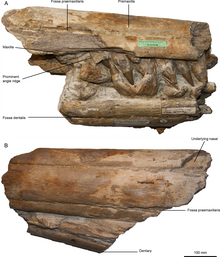Pervushovisaurus
| Pervushovisaurus Temporal range: Cenomanian
| |
|---|---|

| |
| P. campylodon snout fragment, the lectotype specimen of the species | |
| Scientific classification | |
| Domain: | Eukaryota |
| Kingdom: | Animalia |
| Phylum: | Chordata |
| Class: | Reptilia |
| Order: | †Ichthyosauria |
| Family: | †Ophthalmosauridae |
| Subfamily: | †Platypterygiinae |
| Genus: | †Pervushovisaurus Arkhangel'skii, 1998 |
| Species | |
| |
| Synonyms | |
| |
Pervushovisaurus is a genus of platypterygiine ichthyosaur from the Late Cretaceous (Cenomanian) of the Saratov region in western Russia, the La Penthiève Beds of France and the Cambridge area of the UK.
History
[edit]
It was originally described as a subgenus of Platypterygius,[1] but later work showed that it was sufficiently distinct from the type species of Platypterygius, P. platydactylus, to be elevated to full generic rank.[2] The type species of Pervushovisaurus, P. bannovkensis, is known only from the holotype, SSU 104a/24, a partial skull.[3] In 2016, an additional species of Platypterygius from England and France, P. campylodon, was also referred to Pervushovisaurus after previously being allied with Ichthyosaurus in 1846.[4][5][6] A previous Russian species of Platypterygius, "P." kiprianoffi, was also assigned to P. campylodon.[7][8][9]
A specimen of P. campylodon was found in the La Penthiève Beds of France and was described in 1882 by Henri Émile Sauvage.[10]
Description
[edit]
Pervushovisaurus was a medium-sized ichthyosaur measuring 5.8 metres (19 ft) long.[1] Fishcer (2016) gave the emended diagnosis of Pervushovisaurus as follows, based on that of Fischer et al. (2014):[2][6] "Platypterygiine ophthalmosaurid characterized by the following autapomorphies [...]: presence of foramina along the ventral premaxillary–maxillary suture; presence of a semi-oval foramen on the lateral surface of the premaxilla, anteroventral to the external naris; presence of lateral ridges on the maxilla; presence of wide supranarial ‘wing’ of the nasal (a similar structure, although much smaller, is present in ‘Platypterygius’ australis and Acamptonectes densus) (see Kear, 2005; Fischer et al., 2012, respectively); robust splenial markedly protruding from the external surface of the mandible; root with quadrangular cross-section, with the cementum forming prominent 90° angles.
Pervushovisaurus is also characterized by the following unique combination of features: secondarily closed naris surrounded by foramina (as in ‘Platypterygius’ sachicarum and ‘Platypterygius’ australis (see Paramo, 1997; Kear, 2005, respectively), and in Simbirskiasaurus birjukovi, although the ‘anterior’ naris is still present in this taxon (Maisch & Matzke, 2000; Fischer et al., 2014a)); elongated anterior process of the maxilla, reaching anteriorly the level of the nasal (unlike in Aegirosaurus leptospondylus, Sveltonectes insolitus and Muiscasaurus catheti) (Bardet & Fernández, 2000; Fischer et al., 2011a; Maxwell et al., 2015, respectively); rostrum straight (unlike in ‘Platypterygius’ americanus, ‘Platypterygius’ sachicarum, ‘Platypterygius’ australis and possibly Muiscasaurus catheti, where it is slightly curved anteroventrally Romer, 1968; Paramo, 1997; Kear, 2005; Maxwell et al., 2015, respectively); straight, non-recurved tooth crowns (unlike in Sveltonectes insolitus, Muiscasaurus catheti) (Fischer et al., 2011a; Maxwell et al., 2015, respectively)."
References
[edit]- ^ a b Arkhangel’sky, M. S. (1998). "On the Ichthyosaurian Genus Platypterygius". Paleontological Journal. 32 (6): 611–615.
- ^ a b Fischer, Valentin; Arkhangelsky, Maxim S.; Naish, Darren; Stenshin, Ilya M.; Uspensky, Gleb N.; Godefroit, Pascal (2014). "Simbirskiasaurus and Pervushovisaurus reassessed: implications for the taxonomy and cranial osteology of Cretaceous platypterygiine ichthyosaurs". Zoological Journal of the Linnean Society. 171 (4): 822–841. doi:10.1111/zoj.12158.
- ^ Storrs, G. W., M. S. Arkhangel'skii and V. M. Efimov. (2000). Mesozoic marine reptiles of Russia and other former Soviet republics. pages 187-210 In Benton, M. J., M. A. Shiskin, D. M. Unwin and E. N. Kurochkin, (eds.), The Age of Dinosaurs in Russia and Mongolia, Cambridge University Press, Cambridge.
- ^ Carter, J. (1846a). Notice of the jaws of an Ichthyosaurus from the chalk in the neighbourhood of Cambridge. Reports of The British Association for The Advancement of Science.
- ^ Carter, J. (1846b) On the occurrence of a new species of Ichthyosaurus in the Chalk. London Geological Journal. 1846b;1:7–9.
- ^ a b Fischer, V. (2016). "Taxonomy of Platypterygius campylodon and the diversity of the last ichthyosaurs". PeerJ. 4: e2604. doi:10.7717/peerj.2604. PMC 5075704. PMID 27781178.
- ^ "Mesozoic marine reptiles of Russia and other former Soviet Republics". The Age of Dinosaurs in Russia and Mongolia. Cambridge, UK: Cambridge University Press. 2000. pp. 187–210.
- ^ McGowan, C.; Motani, R. (2003). "Ichthyopterygia". Handbook of Paleoherpetology. 8. Munich, Germany: 175.
- ^ Zammit, M. (2012). "Cretaceous Ichthyosaurs: Dwindling Diversity, or the Empire Strikes Back?". Geosciences. 2 (2): 187–210. doi:10.3390/geosciences2020011.
- ^ Sauvage, H.-É., (1882), "Recherches sur les reptiles trouvés dans le Gault de l'est du bassin de Paris", Mémoires de la Société Géologique de France, série 3 2(4): 1-42
External links
[edit]- http://palaeos.com/vertebrates/ichthyosauria/ophthalmosauria.html Pervushovisaurus at Palaeos








